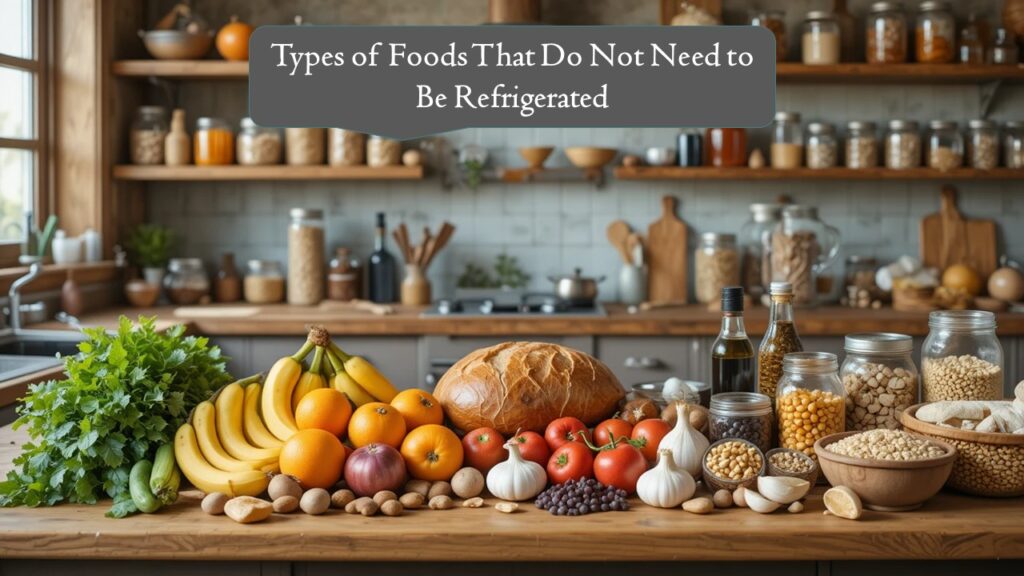In today’s world of overflowing refrigerators and meal prep routines, it’s easy to assume every food belongs in the fridge. But not all foods benefit from refrigeration — in fact, some can lose flavor, texture, or shelf life when stored in cold environments.
Whether you’re trying to save fridge space, reduce food waste, or understand proper storage methods, knowing which foods thrive outside the refrigerator can make a big difference.
In this detailed guide, we’ll explore which foods don’t need refrigeration, why they’re better off at room temperature, and how to store them properly for maximum freshness and safety.
Why Some Foods Don’t Need Refrigeration?
Refrigeration slows bacterial growth, but not all foods are equally affected by temperature. Some contain natural preservatives, low moisture content, or protective skins that keep them stable at room temperature.
Here’s why some foods stay fresh outside the fridge:
- Low moisture: Bacteria and mold need water to thrive. Dry foods like grains and nuts last longer without refrigeration.
- Natural barriers: Skins and peels act as protective layers for produce such as onions, garlic, and citrus.
- Fermentation or preservation: Some foods, like pickles or honey, contain ingredients or natural enzymes that inhibit spoilage.
- Cold sensitivity: Certain fruits and vegetables actually deteriorate faster in the fridge due to cold damage.
-
Fruits That Don’t Need Refrigeration
Some fruits maintain their flavor and texture best when stored at room temperature. However, it’s essential to keep them away from direct sunlight and heat sources.
Bananas
Bananas turn black and mushy in the fridge. Keep them on the counter until ripe, then refrigerate only if necessary to slow further ripening.
Apples
Store apples in a cool, dry place like a pantry. They’ll stay crisp for up to a week or more without refrigeration.
Citrus Fruits (Oranges, Lemons, Limes, Grapefruit)
These fruits have thick skins that protect them from bacteria. Store them in a fruit bowl at room temperature for up to two weeks.
Avocados
Unripe avocados should be kept on the counter until they soften. Only refrigerate once ripe to extend freshness.
Pineapples, Mangoes, and Papayas
Tropical fruits prefer warmer environments. Cold temperatures can alter their texture and sweetness.
-
Vegetables That Should Stay Out of the Fridge
Refrigerating certain vegetables can cause them to wilt, lose flavor, or become grainy.
Onions
Store whole onions in a cool, ventilated spot (like a mesh bag). Avoid storing near potatoes — the gases they emit cause faster spoilage.
Garlic
Keep garlic bulbs in a dark, dry place. Refrigeration encourages sprouting and alters flavor.
Potatoes and Sweet Potatoes
Cold temperatures convert starch into sugar, leading to an unpleasant sweet flavor and gritty texture. A pantry or cupboard is ideal.
Tomatoes
Cold air damages their cell structure, making them mealy. Keep tomatoes stem-side down on the counter until ripe.
Winter Squash (Butternut, Acorn, Spaghetti)
Thick skins make these squashes shelf-stable for weeks. Store them in a cool, dry area.
Cucumbers, Peppers, and Eggplants
Although often kept in fridges, these vegetables are sensitive to cold. Keep them at room temperature for up to three days.
-
Bread and Baked Goods
It’s tempting to keep bread in the fridge to prevent mold, but refrigeration actually dries it out and stales it faster.
Best storage method:
- Store bread in a bread box, paper bag, or airtight container at room temperature.
- If you won’t finish it within a few days, freeze it instead of refrigerating — it maintains texture and flavor better.
-
Dry Goods and Pantry Staples
Dry, shelf-stable ingredients are designed to last without refrigeration.
Rice, Pasta, and Grains
Keep in sealed containers to protect from moisture and pests.
Flour and Sugar
Store in airtight jars in a cool cupboard. Whole grain flours may last longer if refrigerated, but it’s optional for short-term use.
Dried Beans and Lentils
As long as they remain dry, they’re safe at room temperature indefinitely.
Oats, Cereal, and Granola
Moisture is the only enemy here — store in airtight containers for freshness.
-
Condiments and Sauces
Not all condiments belong in the fridge. Many contain salt, vinegar, or sugar, which naturally preserve them.
Examples include:
- Soy Sauce – Naturally fermented and shelf-stable.
- Vinegar and Hot Sauce – Acidic environments prevent bacteria growth.
- Honey and Maple Syrup – Antibacterial and stable at room temperature (just keep tightly sealed).
- Mustard and Ketchup – Can stay out for up to a month after opening, though refrigeration can extend shelf life.
- Oils (Olive, Coconut, Vegetable) – Store in a cool, dark cupboard away from heat to prevent rancidity.
-
Nuts, Seeds, and Nut Butters
Nuts and seeds contain natural oils that can turn rancid in warm environments. However, short-term storage (under two months) at room temperature is fine.
Tips:
- Store in airtight containers to prevent exposure to light and air.
- For long-term storage, consider refrigerating or freezing to preserve flavor.
-
Coffee and Tea
Both coffee and tea lose flavor when refrigerated due to condensation.
Best storage method:
- Keep coffee beans or ground coffee in an opaque, airtight container in a cool, dry place.
- Store tea in sealed tins away from humidity and sunlight.
-
Canned and Jarred Foods
Unopened canned or jarred foods don’t need refrigeration — they’re vacuum-sealed and shelf-stable.
Examples:
- Soups, beans, tuna, and vegetables in cans.
- Jams and pickles (unopened).
Once opened, these should be refrigerated to prevent bacterial growth.
-
Baked and Sweet Products
Honey
A natural preservative that never spoils. Store in a tightly sealed jar away from direct light.
Peanut Butter
Natural peanut butter may separate over time but stays safe at room temperature for several weeks.
Molasses and Syrup
Thick, sugary compositions make them self-preserving.
-
Root Vegetables and Tubers
Root crops evolved to last through long winters without refrigeration.
Examples:
- Carrots
- Beets
- Turnips
- Radishes
Keep them in a cool, dark pantry or cellar in breathable bags. Avoid plastic — it traps moisture and encourages mold.
Foods That Should Always Be Refrigerated
For safety, remember that high-moisture and perishable foods should stay cold:
- Dairy products (milk, yogurt, cheese)
- Cooked leftovers
- Meat, poultry, and seafood
- Fresh-cut fruits and vegetables
- Eggs (depending on your country’s storage guidelines)
Storage Tips for Non-Refrigerated Foods
- Use airtight containers: Prevents pests and moisture exposure.
- Avoid sunlight: Store in cool, shaded areas to maintain freshness.
- Rotate stock: Follow “first in, first out” to use older items first.
- Monitor humidity: Pantry thermometers or silica gel packs help reduce moisture.
Conclusion:
Not all foods need to fight for space in your refrigerator. From hearty root vegetables to pantry staples like grains and honey, many ingredients are naturally shelf-stable and even thrive outside the fridge.
Understanding which foods don’t require refrigeration not only saves space but also preserves taste, texture, and nutrients. With proper storage habits, you’ll waste less food, enjoy better flavors, and make your kitchen more efficient — all while keeping your fridge clutter-free.







